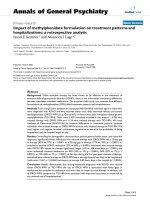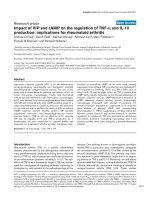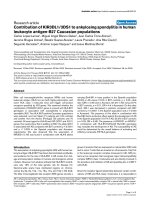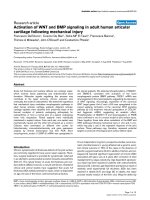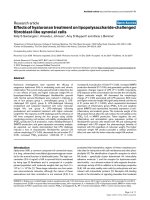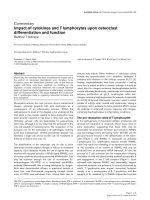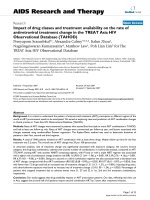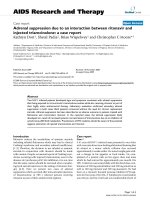Báo cáo y học: " Impact of prolonged treatment with high-dose ciprofloxacin on human gut flora: a case report" potx
Bạn đang xem bản rút gọn của tài liệu. Xem và tải ngay bản đầy đủ của tài liệu tại đây (364.46 KB, 3 trang )
JOURNAL OF MEDICAL
CASE REPORTS
Kourbeti et al. Journal of Medical Case Reports 2010, 4:111
/>Open Access
CASE REPORT
BioMed Central
© 2010 Kourbeti et al; licensee BioMed Central Ltd. This is an Open Access article distributed under the terms of the Creative Commons
Attribution License ( which permits unrestricted use, distribution, and reproduction in
any medium, provided the original work is properly cited.
Case report
Impact of prolonged treatment with high-dose
ciprofloxacin on human gut flora: a case report
Irene S Kourbeti*
1
, Dimitrios E Alegakis
1
, Sofia Maraki
2
and George Samonis
1
Abstract
Introduction: Ciprofloxacin is a commonly marketed fluoroquinolone. It is not effective against obligate anaerobes,
hence it is considered unlikely to have an impact on colonic microflora. We report the case of a patient who received
prolonged treatment with high-dose ciprofloxacin for extensive pelvic osteomyelitis. We also report on the
medication's effects on his bowel flora. To the best of our knowledge, this is the first report discussing the effects of
prolonged administration of a quinolone on microbial flora.
Case presentation: A 62-year-old Caucasian man with diabetes presented with low back pain of four months'
duration. A magnetic resonance imaging of his pelvis revealed sacroiliitis and extensive pelvic osteomyelitis.
Pseudomonas aeruginosa, which is susceptible to ciprofloxacin, was noted as the offending pathogen. After seven
weeks of intravenous treatment, he was prescribed with high-dose oral ciprofloxacin that he continued to take for the
next 20 months. Quantitative stool cultures of our patient were obtained a month later as well as at the end of his
treatment to record his corresponding sensitivities to the medication. The Gram-negative population of his bowel flora
was restored fully upon the discontinuation of this medication. The Gram-negative population was shown to be fully
sensitive to ciprofloxacin. His yeast levels were also found to be slightly increased, and no growth of resistant
enterococci was noted.
Conclusion: The findings of this case report suggest that long term and high dose ciprofloxacin administration might
be safe in preventing the risk of colonization with resistant Gram negative pathogens, overgrowth of anaerobes and
the development of resistant enterococci.
Introduction
Ciprofloxacin remains the most potent of the marketed
fluoroquinolones. Its spectrum includes aerobic Gram-
negative bacilli, particularly Enterobacteriaceae. It is
effective, even under unfavorably anaerobic conditions
involving Haemophilus spp., Neisseria spp. and non-
enteric Gram-negative bacilli, such as Pseudomonas
aeruginosa [1].
However, ciprofloxacin is not considered to be clini-
cally effective against obligate anaerobes. Since the
colonic microflora consists of a vast majority of anaer-
obes, conventional wisdom holds that ciprofloxacin is
unlikely to have a major impact on colonic microflora [2].
We report the case of a patient who received prolonged
treatment with high-dose ciprofloxacin for extensive pel-
vic osteomyelitis.
Case presentation
A 62-year-old Caucasian man with diabetes presented
with low back pain that he had been experiencing for four
months.
An MRI of his pelvis, including his right sacroiliac joint
and pelvic floor muscles, revealed osteomyelitis of the
pubic symphysis and extensive pelvic osteomyelitis.
Pus obtained from his right sacroiliac joint, as well as
several pieces of his sacrum, grew P. aerugino s a .
As is usually done in severe infection with Pseudomo-
nas, our patient was given double antibiotic therapy for
almost two months. His treatment consisted of two types
of antibiotics to which the pathogen was susceptible
(seven weeks of intravenous ciprofloxacin and piperacil-
lin and/or tazobactam).
* Correspondence:
1
Department of Internal Medicine, University Hospital of Heraklion, Voutes,
Crete, 71110, Greece
Full list of author information is available at the end of the article
Kourbeti et al. Journal of Medical Case Reports 2010, 4:111
/>Page 2 of 3
At present, available data are limited to extensive, life-
threatening infections such as in the case of our patient.
The literature, however, consists of cases supporting the
long-term administration of ciprofloxacin monotherapy
in bone infections caused by Pseudomonas after an initial
period of combination therapy [3]. Because of the high
probability of infection recurrence, our patient continued
with high-dose oral ciprofloxacin (1 gram twice a day) for
20 months. Repeat MRIs confirmed a marked improve-
ment of his inflammation, which subsequently led us to
stop his antibiotic therapy.
The quantitative stool cultures of our patient were
studied after 20 months of treatment with oral ciproflox-
acin. After incubation at 37°C under aerobic and anaero-
bic conditions for two to five days, qualitative and
quantitative analyses of the cultures were performed. The
cultures yielded 3 × 10
6
CFU/mL of Escherichia coli, 10
7
CFU/mL of Enterococcus faecium, 2 × 10
4
CFU/mL
Staphylococcus epidermidis, 6 × 10
4
CFU/mL of Coryne-
bacterium group A, 2 × 10
3
CFU/mL of Bacillus stearo-
thermophilus, 10
10
CFU/mL of Bacteroides uniformis, 2 ×
10
9
CFU/mL of Prevotella oralis, 5 × 10
8
CFU/mL of Pre-
votella loescheii and 3 × 10
4
CFU/mL of Candida albi-
cans.
Susceptibilities of aerobes and anaerobes to antibiotics
were performed for five randomly selected colonies of all
bacterial isolates using the disk diffusion method recom-
mended by the Clinical and Laboratory Standards Insti-
tute (CLSI) [4]. As expected, E. coli was resistant to
ciprofloxacin and the rest of the fluoroquinolones tested.
The population of E. faecium, meanwhile, was resistant to
the fluoroquinolones but sensitive to vancomycin. Repeat
stool cultures were taken one month after the discontinu-
ation of our patient's antibiotics treatment, and the same
method was performed. There was a marked increase in
the Enterobacteriaceae population with E. coli at up to 5
× 10
8
CFU/mL. The Gram-negative flora was enriched
with Klebsiella pneumoniae (5 × 10
6
CFU/mL) and Enter-
obacter cloacae (6 × 10
7
CFU/mL). The susceptibility of E.
coli to fluoroquinolones was restored, while K. pneumo-
niae and E. cloacae were also found to be fully susceptible
to fluoroquinolones. A small population of enterococci
(E. faecalis 1.5 × 10
6
CFU/mL and E. avium 2 × 10
6
CFU/
mL) was reported as being intermediately sensitive to the
fluoroquinolones but fully sensitive to vancomycin. The
yeast population decreased from 3 × 10
4
CFU/mL to 8 ×
10
3
CFU/mL, while the anaerobic population remained
basically unchanged.
Discussion
The huge number of anaerobes in the human gut micro-
flora prevents its colonisation and the invasion of tissues
by exogenous pathogenic bacteria including the oppor-
tunists. A disruption of this balance by antibiotics pro-
duces profound effects on the protective barrier and
might result in the overgrowth of pathogens and also in
the development of life-threatening infections. Control-
ling the growth of opportunistic microorganisms is
termed "colonization resistance" [5-7].
The common finding in our patient, the in vitro experi-
ments and the clinical trials, is the significant reduction
in the levels of E. coli[2,5,8]. The E. coli population was
resistant to quinolones but no extended spectrum resis-
tance to β-lactams, especially cephalosporins, was
detected.
Quinolones are notorious for suppressing or even elim-
inating intestinal Enterobacteriaceae [9]. The effect of
antibiotics on the enterococci and the anaerobic popula-
tion varies in different clinical trials, but most of them
have not been used in real situations with prolonged
administrations of high drug doses.
It seems that aside from norfloxacin, quinolones have
produced a minor effect on them [2,8,9]. The overgrowth
of resistant bacteria has not generally been seen [9], nor
has susceptibility to ciprofloxacin for E. coli and entero-
cocci been universal [2]. Studies in patients with cirrhosis
who received quinolones for spontaneous bacterial peri-
tonitis prophylaxis have demonstrated contradictory
results. These studies, however, involved patients who
took quinolones daily for a short period of time [10,11].
Conclusion
Despite the significant reduction and resistance in the E.
coli population and the suppression of the rest of the
Enterobacteriaceae at the end of the ciprofloxacin treat-
ment of our patient, we found neither substantial over-
growth of resistant bacteria or yeasts nor significant
changes in the enterococci or anaerobic population. In
that sense, our findings concur with the ones by Edlund
and Nord [9]. It should be noted that the sensitivity of E.
coli to ciprofloxacin was restored one month after the
drug therapy of our patient was discontinued. This was
confirmed by the findings we made regarding the cultures
performed in the same laboratory and by the same meth-
odology one month after he was started on the treatment
and again at the end of it.
To the best of our knowledge, this is the first reported
case describing the effects of long-term, high-dose cipro-
floxacin administration on colonic flora. The important
conclusions drawn from this case report are the fast
recovery of the intestinal Gram-negative flora and its
complete sensitivity to ciprofloxacin after the discontinu-
ation of the antibiotic, the sustained sensitivity of entero-
cocci to vancomycin, and the preserved anaerobic
population despite a long-term administration of antibi-
otics. The impact of anti-pseudomonas penicillin on the
colonic flora cannot be ignored. However, there was a
Kourbeti et al. Journal of Medical Case Reports 2010, 4:111
/>Page 3 of 3
lapse of 20 months between its discontinuation and the
assessment of the sensitivities of the colonic flora. There-
fore, we consider that the piperacillin and/or tazobactam
impact during the time of testing was negligible. Unfortu-
nately, no sensitivity tests were done immediately after
the antipseudomonal penicillin was discontinued.
The findings of this case report suggest that long term
and high dose ciprofloxacin administration might be safe
in preventing the risk of colonization with resistant Gram
negative pathogens, overgrowth of anaerobes and the
development of resistant enterococci.
Consent
Written informed consent was obtained from the patient
for publication of this case report and any accompanying
images. A copy of the written consent is available for
review by the Editor-in-Chief of this journal.
Competing interests
The authors declare that they have no competing interests.
Authors' contributions
ISK and DEA took care of our patient, reviewed the literature, and wrote most
of the manuscript. SM performed the microbiological studies. GS was the
senior consultant in our patient's care. He also critically reviewed the manu-
script. All authors read and approved the final manuscript.
Author Details
1
Department of Internal Medicine, University Hospital of Heraklion, Voutes,
Crete, 71110, Greece and
2
Department of Clinical Bacteriology, Parasitology,
Zoonoses and Geographical Medicine, University Hospital of Heraklion, Voutes,
Crete, 71110, Greece
References
1. Hooper DC: Quinolones. In Mandell, Douglas, and Bennett's Principles and
Practice of Infectious Diseases Edited by: Mandell GL, Bennett JE, Dolin R.
Philadelphia: Churchill Livingstone; 2005:451-473.
2. Carman RJ, Woodburn MA: Effects of low levels of ciprofloxacin on a
chemostat model of the human colonic microflora. Regul Toxicol
Pharmacol 2001, 33:276-284.
3. Galanakis N, Giamarellou H, Moussas T, Dounis E: Chronic osteomyeltis
caused by multi-resistant Gram-negative bacteria: evaluation of
treatment with newer quinolones after prolonged follow up. J
Antimicrob Chemother 1997, 39:241-246.
4. Clinical and Laboratory Standards Institute: Performance Standards for
Antimicrobial Susceptibility Testing. 16th Informational Supplement.
Approved Standard M100-S16. Wayne, Pennsylvania 2006.
5. Sullivan A, Edlund C, Nord CE: Effect of antimicrobial agents on the
ecological balance of human microflora. Lancet Infect Dis 2001,
1:101-114.
6. Guarner F, Malagelada JR: Gut flora in health and disease. Lancet 2003,
361:512-519.
7. Levy J: The effects of antibiotic use on gastrointestinal function. Am J
Gastroenterol 2000, 95(Suppl 1):8-10.
8. Mavromanolakis E, Maraki S, Samonis G, Tselentis Y, Cranidis A: Effect of
norfloxacin, trimethoprim-sulfamethoxazole and nitrofurantoin on
fecal flora of women with recurrent urinary tract infections. J
Chemother 1997, 9:203-207.
9. Edlund C, Nord CE: Effect on the human normal microflora of oral
antibiotics for treatment of urinary tract infections. J Antimicrob
Chemother 2000, 46(Suppl 1):41-48.
10. Terg R, Llano K, Cobas SM, Brotto C, Barrios A, Levi D, Wasen W, Bartellini
MA: Effects of oral ciprofloxacin on aerobic gram-negative fecal flora in
patients with cirrhosis: results of short- and long-term administration
with daily and weekly dosages. J Hepatol 1998, 29:437-442.
11. Rolachon A, Cordier L, Bacq Y, Nousbaum JB, Franza A, Paris JC, Fratte S,
Bohn B, Bohn B, Kitmacher P, Stahl JP: Ciprofloxacin and long-term
prevention of spontaneous bacterial peritonitis: results of a
prospective controlled trial. Hepatol 1995, 22:1171-1174.
doi: 10.1186/1752-1947-4-111
Cite this article as: Kourbeti et al., Impact of prolonged treatment with high-
dose ciprofloxacin on human gut flora: a case report Journal of Medical Case
Reports 2010, 4:111
Received: 22 October 2009 Accepted: 21 April 2010
Published: 21 April 2010
This article is available from: 2010 Kourbeti et al; licensee BioMed Central Ltd. This is an Open Access article distributed under the terms of the Creative Commons Attribution License ( ), which permits unrestricted use, distribution, and reproduction in any medium, provided the original work is properly cited.Journal of Medical Case Reports 2010, 4:111
